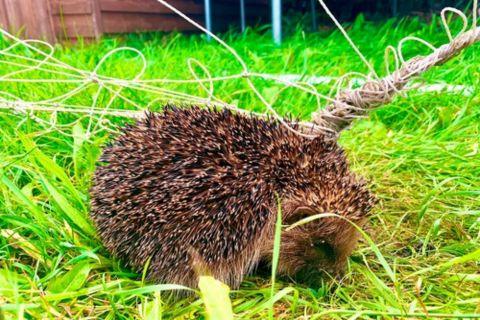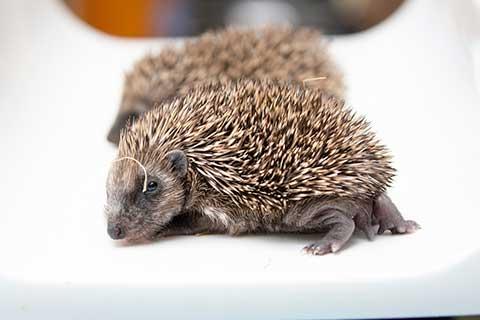Hedgehogs in the garden
Hedgehogs are a gardener's friend, as they eat beetles, caterpillars, worms and other invertebrates. Did you know as many as 10 different hedgehogs may visit a garden over several nights? This could mean 'your hedgehog' is actually a number of different ones visiting at different times! Here's what you can do to help encourage hedgehogs into your garden and keep them happy throughout the year.
Make a hedgehog a home
Leave areas of the garden wild, with piles of leaves, logs or compost. These make an attractive nest, as well as a home for the invertebrates that hedgehogs like to eat.
Making an artificial home can be as simple as placing a piece of board against a wall. Or you can buy a purpose-built hedgehog house - find out how to build your own.
Shop garden and wildlife
Create hedgehog highways
Hedgehogs can travel around a mile every night, so they may need help to get into and out of your garden. Try cutting holes in fences, removing bricks from walls, or digging tunnels under the garden boundary. Hedgehogs can travel through gaps as small as 13x13cm, so these gaps don't need to be large.
Replacing garden fencing for native hedgerows provides access through your garden for hedgehogs. Hedgerows also provide shelter for other wildlife too. Remember to check with your neighbour before making a highway.
Feeding hedgehogs
You can encourage hedgehogs into your garden by providing food and fresh water.
Tips for leaving out food and water:
- Leave out foods like tinned dog or cat food and crushed cat or dog biscuits.
- Supply good quality, meaty hedgehog food from wildlife food suppliers.
- Never feed hedgehogs milk or bread - milk can cause diarrhoea and bread isn't very nutritious.
- Check the food and water bowls each day to top them up with fresh water and food, and remove any food that hasn't been eaten.
- Always clean the dishes - do this outside (not in the kitchen) every day using hot, soapy water and rinse well. This will help to reduce the risks of spreading disease between different hedgehogs that might eat from the same dish.
Hedgehog-friendly gardening tips
Hedgehog-friendly gardening tips
- Cover holes: hedgehogs can easily fall into uncovered drains or holes in your garden. Cover holes or check them every day to make sure no hedgehogs have become trapped.
- Provide an exit route from ponds and pools. Use bricks or stones at the side of the pond. Create a sloped edge on part of the pond to help hedgehogs to climb out if they fall in. Cover swimming pools overnight and when they're not in use.
- Check for hedgehogs before using strimmers or mowers - particularly under hedges, where they might be resting during the day. If you're forking over a compost heap, check them for any nesting hogs first.
- Always thoroughly disturb bonfires immediately before you light them, as there could be hedgehogs nesting or hiding inside. Moving the whole bonfire by hand before setting it alight is the best way of ensuring that hedgehogs and other wildlife aren't sleeping in there.
- Litter is a real hazard to hedgehogs - they can get their heads stuck in tins, plastic bags, binders from drinks cans or discarded yoghurt pots. Make sure you dispose of your rubbish safely and check there's no litter in your garden. Any plastic rings should be cut up, however small they are.
- Raise any netting: if you have any netting or wire in your garden, make sure it's at least a foot above ground level, as hedgehogs can easily become tangled up in it. Pack away or roll up fruit nets, tennis and goal nets when they're not in use. Replace any netting in your garden with solid metal mesh, as it's less likely to entangle hedgehogs.
- Don't close your shed doors if you usually keep them open, as there might be hedgehogs nesting inside. Keep any dangerous chemicals or tools well off the ground. If you need to dismantle your shed, check carefully underneath the floor first for nesting or hibernating hedgehogs.
- Avoid slug pellets and pesticides - these can poison hedgehogs and should only be used as a last resort. Instead, try using one of many natural alternatives, like sprinkling crushed eggshells or coffee grounds around the plants you need to protect. If you have to use pellets, place them under a slate that's inaccessible to hedgehogs. The outdoor use of slug pellets containing metaldehyde was banned in Great Britain from March 2022.

What to do if you disturb a hedgehog
If the hedgehog is hibernating, gently put it back into its nest, re-cover it with the nest material and leave it alone. If this isn't possible - for example, because the nesting site has already been destroyed - then place the hedgehog in a part of the garden where it will be safe and sheltered, with as much of the original nest as possible.
If there's not much natural shelter available, you could use a large box instead, but make sure the hedgehog will be able to get out of the box easily when it next wakes up.
If the hedgehog isn't hibernating and has young hoglets, re-cover them with the nesting material and leave them alone. If this isn't possible, please contact us for more advice.
Find out what to do if you've found an injured or sick hedgehog or an orphaned hoglet in your garden.
Cats, dogs and hedgehogs
Cats aren't normally a problem, as they'll usually leave hedgehogs alone after an initial investigation.
Dogs can attack hedgehogs, so try to keep them away from hedgehogs and monitor or keep your dog on a lead in the garden at dusk or night, when you know the hedgehogs will be out.
You can also 'warn' any hedgehog before you come outside by turning a light on first.
Hedgehogs do carry fleas. However, pet owners don't need to worry as these fleas can only survive on hedgehogs and not on other species.

